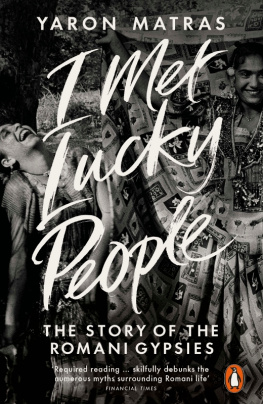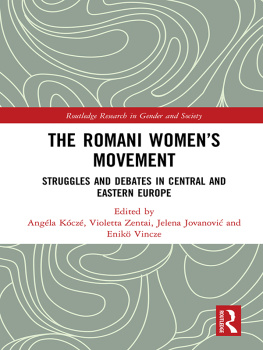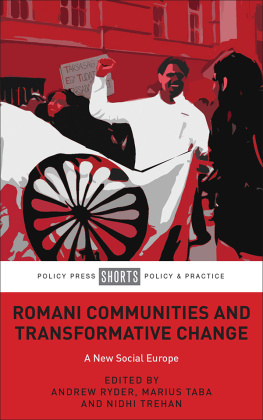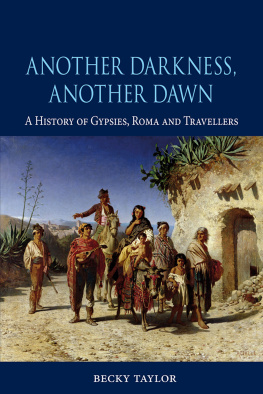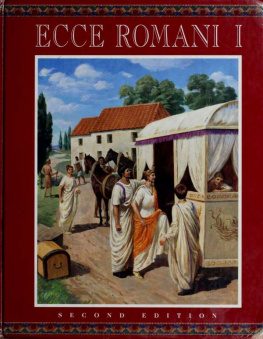Penguin Books is part of the Penguin Random Housegroup of companies whose addresses can be found at global.penguinrandomhouse.com.
1
Who are the Romani People?
THE GYPSY BRAND:MASKS ANDMISREPRESENTATIONS
Its a bright, sunny day in San Francisco,and a cool breeze is blowing from the bay onto Fishermans Wharf. The pier is busy, abustling and buzzing tourist attraction, with its stalls of deep-fried seafood to the right anda line of shops selling bargain merchandise, from clothing to electronics and of coursesouvenirs, to the left. Three young girls, probably not older than fifteen or sixteen, arestanding in the middle of the pavement. They wear their dark hair long and decorate it with aribbon. They look slightly Hispanic, but they stand out because of their long skirts in brightcolours not the typical fashion youd expect from Californian teenagers out to catch thevibe of the big city. As we approach, the girls turn their attention to us. In perfect AmericanEnglish theyre certainly not foreign they offer to tell us our fortune. Their base isa small folding table they have erected on the pavement. Its a makeshift stall, coveredby a big, light-blue cloth, and it can be folded and hidden away in a matter of seconds. Unawarethat the potential customer whom theyve approached is a linguistics professor whospecializes in the Romani language, they exchange a few remarks between them in an idiom theyknow to be unintelligible to most outsiders. They are careful to downplay the casual switch oftongues, lowering their lips and turning their heads at an angle away from the tourists whosecustom they are seeking. Nonetheless, their speech has given them away, if nothing else has.What language are you talking? we ask just to get confirmation and steer theconversation away from the offer of divination. Greek, they say. But they are notGreek. They are Romani, timid to admit their true identity. They know thatthe word Rom or Romani, which they use to refer to their people intheir own language, is meaningless to most outsiders. They could say that they areGypsies, but that might scare the strangers away.
Across the Bay, at the University of Californiain Berkeley, I have just been attending a seminar at the Department of East European Studies. Ileave the building accompanied by a colleague, a distinguished linguist who has spent years ofher career exploring the dialects of small tribes in remote locations around the world. We headtowards the bus stop on Shattuck Avenue. On the way, just around the corner from the universitycampus, I notice a sign in front of one of the shops. It carries the illustration of a hand,ornamented with stars and various other symbols. A woman in her fifties stands in the doorway,talking to a young girl who has positioned herself outside. From afar, their clothes, theiroverall appearance and their gestures remind me of the Romani people I know in central andsoutheastern Europe. They have long, dark hair, fastened with a ribbon behind their head. Theyare wearing long skirts, holding burning cigarettes in their fingers and gesticulatingexuberantly. They notice my stare, and as we come closer my greeting in Romani no longer takesthem completely by surprise. They are fluent in the language, throwing in the occasional Englishall right only as they pause before articulating long sentences in their nativetongue. Their men sell used cars, they say, while the women use the store premises to tellfortunes. Their families number several dozen in Berkeley alone. In reply to my question theystate that their ancestors have been in the country for one hundred years,implying that there is no direct recollection in the family of immigrant grandparents.Generations born in the United States, and yet they remain unknown to their surroundings.Alongside the German-speaking Amish of Pennsylvania and the Yiddish-speaking Orthodox Jews ofBrooklyn, they are among the few groups of Americans who have preserved their old language fouror five generations after they made the journey across the ocean and began to call this countrytheir home. My colleague admitted walking by this very shop on her way home every day over thepast eighteen years, but to her all this was new and astonishing. An invisible minority in themiddle of Berkeley.
A number of Californian cemeteries contain entiresections with plots owned by Romani Gypsies. The gravestones go back almost a century, sometimesmore. They tell an historical narrative that the fortune-tellers pretending to be Greek arequite possibly not even aware of. The oldest names on the graves are often Serbian Nikoli,Markovi, Jovanovi but in the next generation, the same family plots already show the Englishversions of these names: Nicholas, Marks, Johns. Like others pursuing the American dream, theyvalued the appearance of blending into the melting pot. But they remained the people they hadbeen for centuries, with their particular dress, their own language, intact family and clanstructures, and a preference for a certain portfolio of trades, which, however exotic, caters tothe demands of those around them.
The ancestors of these Romani people beganarriving in America in the 1880s as part of a wave of eastern European immigrants. They joinedthe population of Romnichals Romani families from England and Wales who had crossed the oceanalready in the first decades of the nineteenth century. Some people estimate that the AmericanRoms number around 200,000 today, perhaps even more. Their distinct sub-groups ornations include the Romnichals, the Kelderasha, the Rusurya orRussians and the Machwaya. The latter, quite possibly the largest Romani group inthe western United States, derive their name from the region in which they lived just beforeleaving Europe Mava in Serbia. This explains the Serbian nameson the gravestones. But the people are not Serbian, nor Greek. The Romani dialect they speakcontains many Romanian and Hungarian words, and their customs are shared with Romani Gypsies whostill live in Transylvania and with others who left that region in the middle of the nineteenthcentury. On the rare occasions when Romani Gypsies meet south Asians from India or Pakistan,they are astonished to discover that they can understand many of the words these people use intheir own languages, such as Hindi, Urdu and Punjabi. There is thus a connection not just witheastern Europe Romania and Hungary but also with far-away India. A cosmopolitan identity,with a history of travels and a disguised appearance: who are the Gypsies?
In Berkeley, you can buy clothes in a shop calledGypsy Streetwear and have your hair done at the Gypsy Rose Hair Salon. Back in San Francisco you can pay a visit to Gypsy Jeans or, for more specificrequirements, turn to Gypsy Rosalies Wigs and Vintage. The artistic can explore TrailerGypsy Crafts or Gypsy Moon Design. Places to eat out include Gastro Gypsy and to find your wayyou might draw on the services of Trippin Gypsy Maps. Altogether there are over 350outlets in the San Francisco Bay area that carry the word Gypsy in their title.The great majority, if not indeed all, are not managed by Romani Gypsies nor do they caterspecifically for Romani customers. They just exploit the image.

